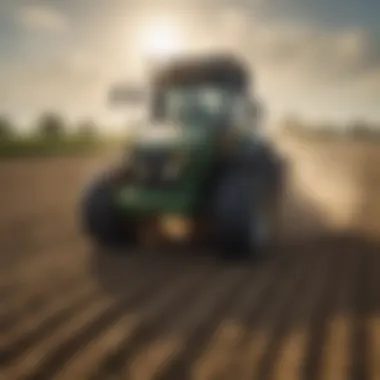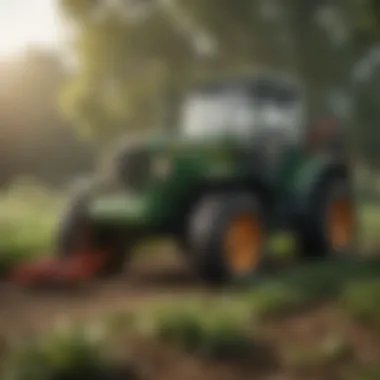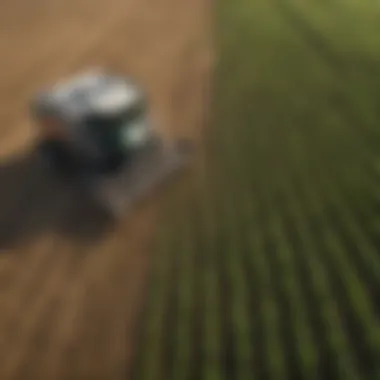Exploring Cruiser Maxx Seed Treatment Benefits


Intro
Cruiser Maxx is gaining significant traction in the agricultural sector, with many farmers and agricultural professionals looking to enhance their crop yields and manage pests effectively. This seed treatment product offers various benefits that contribute to sustainable agricultural practices. Understanding its composition, application methods, and effectiveness against potential threats becomes crucial for stakeholders aiming for optimal farm productivity.
Topic Overview
Definition and Importance
Cruiser Maxx is a chemical treatment applied to seeds before planting. Its primary purpose is to protect seeds and seedlings from early-season pests and diseases. The product's active ingredients work to defend against various insects, including aphids and rootworms, and provide a shield against certain soil-borne pathogens. This is especially important in modern agriculture, where maximizing yields while minimizing chemical use is essential for sustainability.
Brief History and Evolution
The development of seed treatments has evolved over the decades. Initially dominated by a few active ingredients, the introduction of Cruiser Maxx marked a shift toward combining multiple modes of action in a single product. This innovation allows for better agricultural resilience against emerging pest and disease pressures while aligning with integrated pest management strategies. Understanding this evolution helps farmers appreciate the need to adapt to changing agricultural circumstances.
Key Techniques and Innovations
Sustainable Farming Practices
The implementation of Cruiser Maxx fits well into sustainable farming practices. Using this seed treatment can reduce the need for foliar insecticides, leading to less chemical runoff and lower impacts on beneficial insect populations. By employing Cruiser Maxx, farms can enhance their eco-friendly credentials and foster biodiversity.
Advanced Agronomic Technologies
As agricultural technologies advance, the role of seed treatments like Cruiser Maxx is being integrated with precision farming tools. These technologies allow farmers to apply treatments more efficiently, monitor crop health in real-time, and tailor management practices to specific field conditions. This integration can drive better outcomes in terms of yield and pest control effectiveness.
Practical Applications
Step-by-Step Guides
- Selection of Seeds
Choose high-quality seeds that are compatible with Cruiser Maxx treatment. - Application of Treatment
Follow the manufacturer's guidelines to treat seeds with Cruiser Maxx. Ensure uniform coverage for optimal protection. - Planting
Plant treated seeds at appropriate times, considering soil temperature and moisture. - Monitoring and Maintenance
After planting, monitor crops closely for any signs of pest pressure or disease. - Harvesting
Once crops reach maturity, proceed with harvesting, noting any variations in yield to evaluate product effectiveness.
Case Studies or Real-World Examples
Farmers across various regions have documented their experiences with Cruiser Maxx. In one case study, a corn farmer in Iowa reported a 15% increase in yield after using Cruiser Maxx compared to untreated seeds in the same field. This highlights the practical benefits of seed treatments in different agricultural settings.
The adoption of seed treatments like Cruiser Maxx is more than just a trend; it represents a critical step towards more sustainable and productive farming.
Understanding these techniques and practices helps further grasp the importance of products like Cruiser Maxx in modern farming.
Preface to Seed Treatments
Seed treatments hold a crucial position in contemporary agricultural practices. Their primary goal is to enhance the initial growth of plants by safeguarding seeds from pests and diseases. As environmental challenges increase, understanding how to effectively use products like Cruiser Maxx becomes essential. This section outlines the fundamental concepts of seed treatments, establishing a framework for their importance and utility in farming.
Definition and Purpose
Seed treatments refer to the application of specific substances to seeds before planting. The main aim is to prevent early-season diseases and pest infestations. These treatments can either be chemical or biological. By coating the seed, farmers can ensure that the young plants have a better chance of survival and growth. The importance lies in the notable increase in germination rates and overall plant health, which can directly translate into higher yields.
Treatments like Cruiser Maxx not only protect from harmful organisms, but they also enhance resistance to various diseases. The dual purpose of seed treatment creates a more resilient agricultural ecosystem.
Historical Context


Historically, the practice of treating seeds dates back thousands of years. Ancient civilizations recognized the need to protect their crops and began using natural substances for this purpose. Over time, the methods evolved with advancements in chemistry and technology.
The introduction of synthetic pesticides and treatments revolutionized the farming landscape in the 20th century. They became more effective at targeting specific pests and diseases. Today, growers can select from a wide range of products tailored to their crop needs. Cruiser Maxx, for instance, represents a modern approach to seed treatment, combining various active ingredients to offer robust protection and enhance crop performance.
As agriculture continues to evolve, so do the strategies associated with seed treatment. Awareness of environmental impact and the increased demand for sustainable practices shape how these treatments are developed and applied. Understanding this context allows stakeholders to make informed decisions about their farming practices and the use of products like Cruiser Maxx.
Overview of Cruiser Maxx
In today's progressive agriculture, seed treatments like Cruiser Maxx have gained significant attention. The relevance of this topic cannot be understated. The effectiveness of Cruiser Maxx in enhancing seed performance and protecting crops makes it crucial for farmers and agronomists to understand its applications. This section will explore the composition of Cruiser Maxx, analyzing its active ingredients and the mechanisms that enable its effectiveness.
Composition and Active Ingredients
Cruiser Maxx is primarily composed of several active ingredients, each playing a specific role in seed protection. The main active ingredients include thiamethoxam and mefenoxam. Thiamethoxam belongs to a class of insecticides called neonicotinoids, which are known for their ability to target pests effectively with a low concentration. Mefenoxam is a fungicide that helps manage seed-borne diseases. These substances, when combined, create a robust treatment for seeds, ensuring they are protected against pests and diseases as they germinate.
Another essential component includes polymers that aid in adhering the treatment to the seed surface. This adhesion is vital for ensuring that the active ingredients are released effectively during the early growth stages. Their formulation allows Cruiser Maxx to be both effective and efficient, facilitating ease of use for farmers.
Mechanism of Action
Understanding how Cruiser Maxx works is essential for utilizing it effectively. Thiamethoxam functions by disrupting the normal nervous system activity in insects, leading to paralysis and death. It is especially potent against common pests like aphids and wireworms. The action occurs when the active ingredient binds to nicotinic acetylcholine receptors, which are critical for nerve transmission in insects.
On the other hand, mefenoxam targets fungi by inhibiting the synthesis of RNA. This intervention is crucial, as many crop diseases originate from fungal infections. By preventing these pathogens from establishing themselves, Cruiser Maxx not only protects the seeds but also promotes overall plant health, which translates to increased yield and productivity.
In summary, the combination of these active ingredients gives Cruiser Maxx the necessary strength to combat both pests and diseases effectively. Farmers adopting these treatments can expect better seed viability leading to healthier crops.
Benefits of Cruiser Maxx Seed Treatment
The use of Cruiser Maxx seed treatment holds significant importance in modern agriculture. Its contribution can be seen not only in the way it combats various threats to seeds but also in enhancing the overall performance of crops. Understanding these benefits can help agricultural professionals make educated decisions regarding their crop management practices.
Effective Pest Control
One of the leading advantages of Cruiser Maxx is its efficacy in pest control. This seed treatment provides a protective barrier against a range of common pests that threaten seeds and seedlings. Pests such as aphids, rootworms, and thrips can severely damage crops at their early stages. Cruiser Maxx utilizes a combination of neonicotinoids to disrupt the normal functioning of these pests. When seeds are treated, the active ingredients are absorbed into the plant, protecting it as it grows. This systemic action ensures that even after germination, the plant remains safeguarded against further infestations.
Disease Resistance
In addition to pest protection, Cruiser Maxx significantly enhances the seedling's resistance to diseases. Many pathogens, including fungi and bacteria, pose risks that can derail plant development. By treating seeds with Cruiser Maxx, farmers can reduce the incidence of diseases like damping-off and various soil-borne pathogens. The active ingredients in Cruiser Maxx not only bolster the plant's innate immune response but also create a more resilient crop overall. This reduction in disease susceptibility is crucial for maintaining healthy yields and limiting the need for additional chemical interventions later in the growth cycle.
Enhanced Germination Rates
Germination is a critical stage in the life cycle of a crop. Cruiser Maxx can improve seed vigor, which in turn enhances germination rates. When seeds are treated, they tend to absorb water and nutrients more efficiently, promoting stronger and quicker germination. Reports show that treated seeds often emerge more uniformly compared to untreated ones. This uniformity can lead to better crop establishment and ultimately contribute to a more productive planting season. By ensuring that a higher percentage of seeds germinate, farmers can maximize their efforts and resources.
Improvement in Crop Yield
The culmination of the aforementioned benefits often leads to substantial improvements in crop yield. By providing a protective shield against pests and diseases and enhancing germination rates, Cruiser Maxx creates an optimal growing environment for plants. Increased yields are not just the result of effective immediate pest and disease management; they also arise from the restored balance in the soil ecosystem and improved seedling health. Research indicates that farms utilizing Cruiser Maxx have seen yield increases compared to those using untreated seeds. This boost is particularly noteworthy in high-value crops, where maximizing production is essential.
Ultimately, the benefits of Cruiser Maxx seed treatment extend beyond just pest control. By investing in such treatments, farmers are investing in the very foundation of their crop success.
Application Methods for Cruiser Maxx
Understanding the application methods for Cruiser Maxx is crucial to realizing its full potential in seed treatment. Different methods of application can significantly influence the effectiveness of Cruiser Maxx in protecting seeds and ensuring optimal growth. Various techniques, timing considerations, and equipment options must be carefully chosen to maximize the benefits of this seed treatment product.
Seed Coating Techniques


Seed coating is the process of applying Cruiser Maxx to the seed surface. This method delivers treatment directly to the seed, enhancing protection against pests and diseases. Several techniques exist for coating seeds:
- Drum Coating: Seeds are placed in a rotating drum where they are coated evenly with a liquid solution of Cruiser Maxx. This technique allows for a consistent application of the treatment.
- Pelleting: Seeds can be coated with Cruiser Maxx and encased in a pellet made of various materials. This process not only applies the treatment but also improves seed handling and planting precision.
- Pneumatic Coating: In this technique, a pneumatic system sprays Cruiser Maxx onto moving seeds, allowing for a thorough and even coverage.
Each technique has unique advantages depending on the seed type and the specific requirements of the cropping system. Choosing the right method can directly impact not only the efficacy of the seed treatment but also the overall seed performance in the field.
Timing and Dosage Recommendations
Proper timing and dosage are critical for the effective application of Cruiser Maxx. Generally, the best time to apply the seed treatment is right before planting. This ensures that seeds receive maximum protection during their vulnerable germination period.
Dosage varies depending on the crop and local pest pressure. Agricultural best practices recommend:
- Following Manufacturer Guidelines: Always adhere to the dosage instructions provided on the product label for optimal results.
- Weather Considerations: Avoid application during extremely damp or windy conditions to ensure that the treatment adheres properly to the seeds.
If farmers apply less than recommended, they may not get the full extent of pest and disease protection, while overdosing can lead to environmental concerns and potential crop injury. Proper calibration of application equipment is essential to achieve the correct dosage.
Equipment for Application
The choice of equipment greatly affects the application process of Cruiser Maxx. Using the right machinery ensures that seeds are coated uniformly and without damage. Commonly used equipment includes:
- Seed Treaters: Machines specifically designed for applying liquid treatments to seeds. They can handle both small and large seed batches efficiently.
- Planters with Built-in Applicators: Some modern planters come equipped with capabilities to apply seed treatments as the seeds are planted.
- Handheld Sprayers: For smaller applications or specific cases, these sprayers can apply Cruiser Maxx directly onto seeds.
Maintaining equipment is also important. Regular calibration checks can help ensure that the right amount of Cruiser Maxx is being applied.
"The method of application, timing, and proper equipment are critical factors in maximizing the benefits of Cruiser Maxx seed treatment."
Regulatory Considerations
Understanding regulatory considerations is crucial for the application of Cruiser Maxx seed treatment. Regulations ensure the safety and efficacy of seed treatments, protect the environment, and safeguard public health. They provide a framework that governs how agricultural products are developed, tested, and used. For agricultural stakeholders, being compliant with these regulations not only helps in adhering to legal standards but also fosters trust with consumers and the community.
Government Guidelines
Government guidelines play a pivotal role in the regulation of seed treatments like Cruiser Maxx. These guidelines are often established by environmental protection agencies and agricultural departments. They focus on several key areas:
- Registration: Any seed treatment must be registered before it can be marketed. This process involves extensive testing to assess both the product’s effectiveness and potential impacts on human health and the environment.
- Labeling Requirements: Guidelines dictate what information must be provided on product labels. This information includes application rates, safety precautions, and any potential risks associated with use. Adequate labeling is essential for informing users on how to apply Cruiser Maxx effectively and safely.
- Usage Restrictions: Some governments may impose restrictions on when and how a product can be used. For instance, there may be limitations on applying Cruiser Maxx during certain growth stages of crops to avoid potential harm to beneficial organisms.
These government guidelines are updated regularly based on new research, technological advancements, and emerging risks. Compliance with these regulations also facilitates trade and international acceptance of agricultural products.
Environmental Impact Assessments
Environmental impact assessments (EIAs) are critical in the regulatory landscape for Cruiser Maxx. They evaluate the potential environmental effects before a seed treatment is approved. EIAs consider various factors:
- Biodiversity: Assessing how Cruiser Maxx affects local ecosystems, including non-target species, is essential. This includes understanding the impact on beneficial insects, aquatic organisms, and soil health.
- Soil Health: The long-term effects of seed treatments on soil microorganisms and overall fertility are evaluated. It is important to determine whether the use of Cruiser Maxx supports or detracts from soil vitality.
- Water Quality: The potential for runoff or leaching into waterways raises concerns for water quality. Assessing these impacts helps in implementing measures to protect water sources.
"Environmental impact assessments help balance agricultural productivity with ecological sustainability."
Conducting EIAs is not just a legal requirement; it also reflects a commitment to sustainable agricultural practices. This process can lead to improved strategies that minimize negative consequences, ensuring that products like Cruiser Maxx contribute positively to farming systems while protecting the environment.
Challenges and Controversies
The topic of challenges and controversies in seed treatments, particularly with Cruiser Maxx, is highly relevant in contemporary agriculture. Understanding these issues is crucial for farmers and agri-businesses seeking to manage risks effectively while maximizing the benefits of seed treatments. This section will explore significant elements such as resistance development and public perception.


Resistance Development
One of the most pressing concerns surrounding the use of Cruiser Maxx is the potential development of resistance among pests. Over time, continuous exposure to insecticides can lead to a subset of pest populations that are less affected by the compounds used. This phenomenon can undermine the efficacy of the treatment, making it increasingly difficult for farmers to control pest populations effectively. The speed at which resistance develops can vary significantly based on several factors, including the type of pest, the frequency of applications, and the specific active ingredients used in Cruiser Maxx.
Farmers must adopt strategies to mitigate resistance. These strategies could include rotating different classes of insecticides, integrating non-chemical control methods, and monitoring pest populations regularly. By diversifying pest management techniques, farmers can reduce the pressure on any single active ingredient, thereby prolonging its effectiveness. Ensuring a diverse approach not only helps in maintaining crop yields but also supports sustainable agricultural practices.
Public Perception and Misunderstandings
Public perception of seed treatments like Cruiser Maxx often reflects a mixture of misconceptions and factual information. Many individuals involved in agriculture may find themselves navigating a complex landscape of opinions and information. Misunderstandings about the safety, environmental impact, and necessity of such treatments can deter farmers from using valuable products.
A significant issue is the belief that all seed treatments are harmful to the environment. Although it is true that some products can pose risks, responsible use and adherence to regulatory guidelines can ensure minimal impact. Moreover, education plays a vital role in shaping perceptions. By providing data on efficacy, safety measures, and benefits, stakeholders can inform the public and demystify the application of seed treatments.
"Effective communication and education can change the narrative around seed treatments, leading to more informed decisions by farmers and stakeholders alike."
Furthermore, addressing these misconceptions helps promote the responsible use of Cruiser Maxx while maintaining high agricultural standards. This dialogue between farmers, regulators, and the public is critical to fostering a better understanding of the importance of seed treatments in modern agriculture.
In summary, the challenges and controversies surrounding Cruiser Maxx are vital for farmers to navigate. Increased awareness, education, and diversified management strategies are essential for addressing resistance development and improving public perception of seed treatments.
Future Trends in Seed Treatments
The future of seed treatments is evolving rapidly, influenced by technological advancements and a growing demand for sustainable agricultural practices. As global population increases, the pressure on farmers to produce more with less resource draws attention to innovative solutions in the field of seed treatment. These trends not only enhance productivity but also support environmental stewardship.
Advancements in Technology
Technological advancements play a crucial role in shaping the future of seed treatments. Developments in biotechnology are leading to the creation of more effective seed treatments that target specific pests and diseases with greater precision. For instance, the use of genetic modifications allows for the breeding of seeds that are resistant to certain insects or pathogens.
Moreover, precision agriculture technologies are also transforming how seed treatments are applied. Data analytics and GPS-guided machines enable farmers to optimize application rates and timings, reducing waste and increasing efficiency. The integration of artificial intelligence in monitoring crop health can significantly improve the management of seed treatments, allowing early detection of potential issues and tailored solutions based on real-time data.
Additionally, advances in coating technologies ensure that seed treatments adhere better and protect the seeds during initial growth stages. This protection can maximize the potential for germination and early growth, contributing to a more robust crop yield.
The push for innovative solutions in agriculture is vital for meeting global food security challenges.
Sustainable Practices in Seed Treatment
The trend towards sustainable seed treatments reflects a broader commitment to environmental care within agriculture. As consumers become more conscious of the ecological impacts of farming, there is a noticeable shift toward practices that prioritize sustainability. This includes the adoption of organic and more biodegradable seed treatments.
Sustainable practices involve the reduction of chemical inputs and the use of integrated pest management strategies. By combining mechanical, biological, and cultural methods, farmers can minimize reliance on synthetic chemicals. This approach not only helps maintain soil health but also reduces the risk of chemical runoff into local water sources.
In addition, many seed treatment developers are focusing on environmentally friendly formulations. For example, some companies are investing in natural biopesticides derived from plant extracts or beneficial organisms. These treatments can provide effective pest control without the harmful effects associated with traditional chemical solutions.
Culmination
Concluding the exploration of Cruiser Maxx seed treatment reveals the significant impact this product can have on modern agriculture. Understanding the benefits it offers, such as enhanced pest control, disease resistance, and improved crop yield, is essential for farmers looking to optimize their crop production.
Summary of Key Points
- Effective Pest Management: Cruiser Maxx demonstrates high efficacy against a range of pests, protecting seeds during their crucial early growth phase.
- Disease Prevention: The formulation not only deals with pests but also aids in reducing disease incidence, which can adversely affect plant health and yield.
- Germination and Yield Improvement: Studies indicate that the use of Cruiser Maxx can lead to better germination rates and, subsequently, higher crop yields.
- Application and Compliance: Knowledge of proper application methods and understanding regulatory guidelines are critical to leveraging the full advantages of Cruiser Maxx while ensuring environmental safety.
- Future Trends: As agricultural practices evolve, Cruiser Maxx stands at the forefront of innovations aimed at sustainability and efficiency in crop production.
Final Recommendations
For stakeholders in agriculture, it is recommended to:
- Adopt Integrated Pest Management (IPM): Utilize Cruiser Maxx in conjunction with other sustainable practices to maximize effectiveness and minimize resistance development.
- Educate on Proper Usage: Focus on thorough training for application methods, proper timing, and dosage to ensure that the benefits of Cruiser Maxx are fully realized.
- Monitor Crop Health: Regularly assess the health of the crops to adjust treatments based on specific pest and disease pressures encountered.
- Stay Informed on Regulations: Keep up with the latest government guidelines and environmental assessments that relate to seed treatments to ensure compliance and optimal practices.
"Sustainability in agriculture is not a distant goal; it is a necessity for the future of food security and ecosystem health."
In summary, the intelligent application of Cruiser Maxx, matched with best farming practices, can significantly elevate crop performance and contribute to a more productive, sustainable agricultural landscape.



